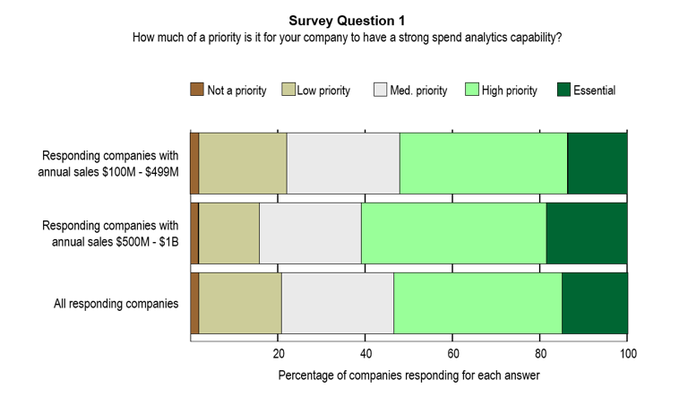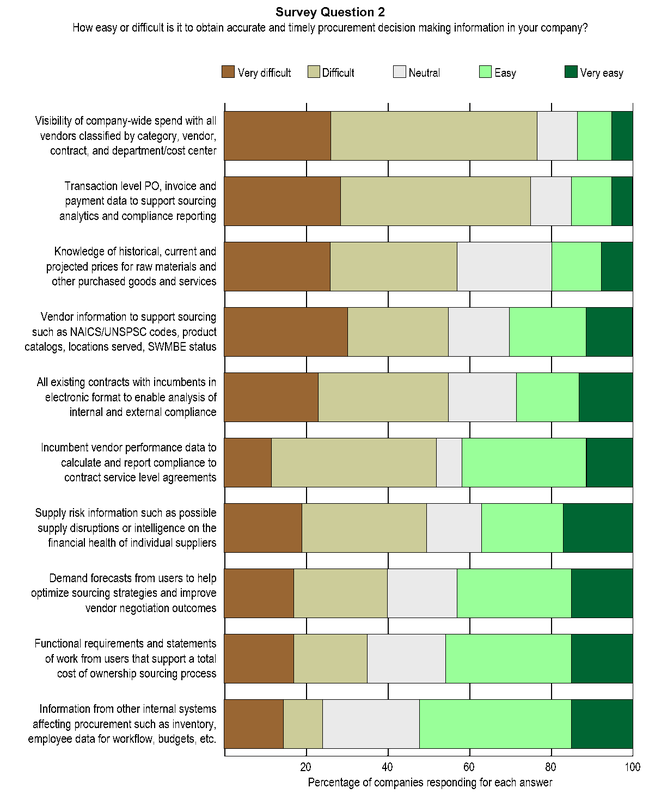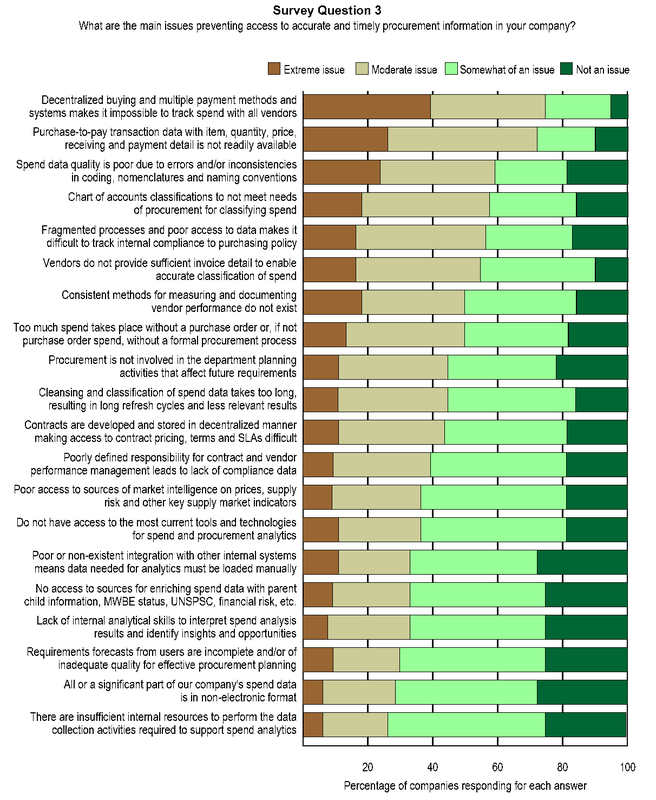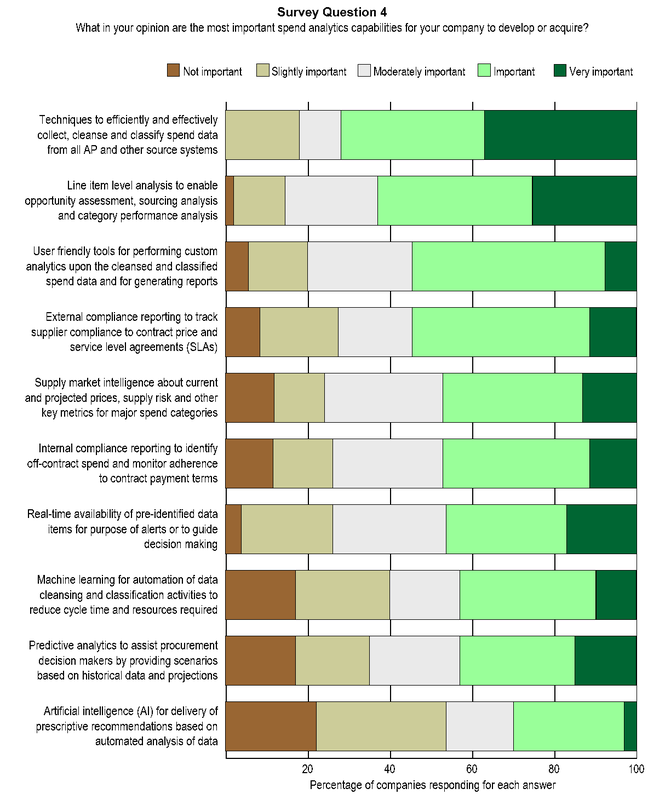|
In the first part of my post Is Spend Analytics the Next Consulting Services Money Engine? I discussed my personal opinions and observations about how the current market for spend analytics services seems similar in some ways to strategic sourcing consulting in the 1990s. I also revealed the results of a focus group meeting of 18 small to medium sized companies I hosted in November 2017 that strongly suggested providers might not have a full and accurate understanding of the primary issues and concerns of the mid-market when it comes to spend analytics. In this second part of the post I will present the key findings of a comprehensive survey of the mid-market I conducted earlier this year, the objective of which was to investigate whether the findings of the 2017 focus group were truly representative of the mid-market on a statistically defendable basis. The complete survey report titled Spend Analytics in the Mid Market: The Real Story can be downloaded with a registration on the SpendWorx website but a summary of the survey approach, results and conclusions are provided below. Survey Approach During January and February 2018, I worked with a third party survey company TTL Inc. to issue online surveys to the executives responsible for procurement at 6,717 US companies in all states with annual revenues between $100M and $1B across multiple industry sectors. Usable responses were obtained from the head procurement executives at 419 companies. This equates to a response rate of 6.2%, which is in line with typical response rates for comparable surveys. The three largest industry sectors represented by the respondents were manufacturing (109 companies, or 26%), wholesale (88 companies, or 21%) and retail (71 companies, or 17%). In terms of annual revenues 45% of the companies fall in the range $250M - $499M, 35% in the range $100M - $249M, 13% in the range $250M - $749M and 7% in the range $750M - $1B. Survey Results Survey Question 1: How much of a priority is it for your company to have a strong spend analytics capability? Of the 419 responding procurement executives, some 222 (53%) stated that spend analytics was either a high or essential priority in their companies (see Figure 1 below). Of the 84 executives working for companies with annual revenues of $500M-$1B this percentage increased to 61% (51 companies) confirming the widely held view that larger companies with higher procurement expenditures will generally implement tighter control over their spend. For the 335 companies with annual revenues of $100M-$499M, the percentage of them for which spend analytics was a high or essential priority stayed respectably high at 51%. Figure 1 Survey Question 2 - How easy or difficult is it to obtain accurate and timely procurement decision making information in your company? Here the survey respondents were asked to assess ten types of procurement-related information in terms of the ease or difficulty of obtaining the information in an accurate and timely form in their companies. The results in Figure 2 below show that the three types of information assessed as being most difficult to obtain in accurate and timely form are company-wide cleansed and classified spend, transaction level procure-to-pay data, and market price information. Procurement-related information presenting less of a challenge is internal systems information required to support procurement processes (e.g. financials, inventory, HR. etc.) functional requirements for sourcing, and user demand forecasts. Figure 2 Survey Question 3 - What are the main issues preventing access to accurate and timely procurement information in your company? In this question the survey respondents were provided with a list of 20 commonly faced procurement data issues and asked to indicate the degree to which each was an issue in their own company. It can be seen from the results in Figure 3 below that the issues identified as causing the most problems are strongly correlated with the types of decision making information that are most difficult to obtain in accurate and timely form from Figure 2 above. For example, the top 3 issues in Figure 3 (decentralized buying, lack of detailed transaction data and poor data quality) all directly contribute to the fact that accurate and timely company-wide cleansed and classified spend is the most difficult type of information for procurement decision makers to obtain in Figure 2. Other issues identified as either extreme or moderate by more than 50% of the executives included non-useful chart of account descriptions, lack of detail on vendor invoices, lack of a consistent vendor performance measurement methodology, and too much spend without a purchase order. Issues identified by the responding executives as less of a concern towards the bottom of Figure 3 included insufficient internal resources for data collection, spend data in non-electronic format, poor or incomplete requirements forecasts from users, and lack of internal analytical skills to identify insights and opportunities from spend data. Figure 3 Survey Question 4 - What in your opinion are the most important spend analytics capabilities for your company to develop or acquire? In this final question the responding mid-market procurement executives were provided with a list of spend analytics-related capabilities and asked to identify which in their opinion were the most important capabilities for their company to develop or acquire bearing in mind their company’s unique procurement and data environment. From Figure 4 below it can be seen that over 80% of the procurement executives identified techniques to efficiently and effectively cleanse and classify spend data from all AP and other source systems as either very important or important. Over 50% of respondents further identified line item analysis, user friendly analytics and reporting tools (for working on the already cleansed and classified data) and supplier compliance as capabilities that were also either very important or important for their organizations. Some of the capabilities regarded as lower in importance (at least at this moment in time) included artificial intelligence (AI), predictive analytics and machine learning. Figure 4 Conclusions The survey of mid-market procurement executives produced findings consistent with the November 2017 focus group in a number of areas, namely: Continuing challenges with basic spend analysis issues. The survey confirmed the finding of the focus group related to continuing issues with procurement data. Based on the survey results, mid-market companies still experience significant difficulties in achieving enterprise-wide spend visibility due to challenges in extracting, cleansing and classifying spend data. Advanced spend analytics technologies not yet on radar. A clear finding from the survey was that mid-market procurement executives are more concerned with ‘block and tackle’ issues like cleansing, classification and getting a basic analysis and reporting capability up and running than they are about AI, cognitive procurement or machine learning. The implication is that until the mid-market has spend visibility mastered, the penetration of advanced analytics into the sector will be limited. Smaller companies are on board with the power of procurement. For over 50% of responding companies between $100M-$500M annual revenues to identify spend analytics as an essential or high priority is a clear indicator of how far smaller mid-market enterprises have come in embracing the value of a proactive approach to procurement. Small companies that move first to implement strong spend analytics capabilities stand to gain significant and sustainable cost and profitability advantages over their similarly sized competitors. Lessons for solution providers. Another theme of the November 2017 focus group corroborated by the survey was the perception that technology providers did not understand some of the unique requirements of mid-market companies compared to Fortune 500 companies when it came to spend analytics. The surprisingly low importance placed on the newer technologies in the survey should be a warning to solution providers that the majority of mid-market companies still need help finding their way out of the spend visibility forest. Only then will they be able to look ahead and appreciate the value that the new technologies will bring. The complete survey report Spend Analytics in the Mid Market: The Real Story can be downloaded with a registration on the SpendWorx website here.
1 Comment
|
1 Procurement Place
Non-spin commentary on the world of procurement, supported every now and then by the occasional piece of factual information. Mark Usher
Mark is Founder and CEO of SpendWorx LLC, a provider of spend analytics services. Prior to SpendWorx Mark co-founded Treya Partners, a boutique procurement consultancy. Earlier in his career Mark held various positions at Accenture, GE Aviation and Rolls-Royce.
Archives
December 2022
|






 RSS Feed
RSS Feed